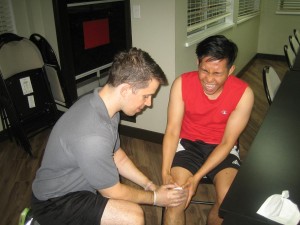Due to the impact-free nature of cycling, it is considered as an ideal sport for those who want to avoid incurring any form of injury. Knee injuries can occur with cycling or indoor cycling. If the individual does not observe proper training techniques, overuses the knees or the equipment used does not fit correctly, knee pain will manifest after a workout session. It is recommended to resume biking after figuring out the possible cause for the pain. A doctor should be consulted if the usual fixes or remedies could not resolve the knee issues.
Patellofemoral pain syndrome
This syndrome can cause pain under or around the patella that tends to worsen with activity or extended periods of sitting with the knees flexed. The knee pain is associated with the rubbing action on the thigh bone. This might also be due to foot issues, inward curving legs, heavy lifting, muscles weakness in the thighs and tight muscles of the lower legs and back.
The possible causes include seat height, overuse or a kneecap that is naturally out of proper alignment with the thigh bone. The treatment for patellofemoral pain syndrome includes quadriceps muscle strengthening, rest, application of ice as needed or after exercise and correct shoe fitting.

Iliotibial band friction syndrome
When it comes to iliotibial band friction syndrome, it is an injury that is often associated to cycling. The iliotibial band is described as fibrous tissue that starts at the hip and travels down the side of the leg and inserts right below the knee. The constant nature of cycling can cause this band to rub which produces friction against the bones around the knee, thus resulting to pain. The pain from this form of injury often manifests right below the knee or on the exterior side right above the knee. Correct training and equipment can avert this injury.
Incorrect training techniques
Always bear in mind that proper training can prevent cycling knee injuries. It is recommended to build up time on the bike gradually, stretch after a ride, warm up and cool down and include rest periods on the weekly ride schedule. Remember that cadence is another training tool that can help prevent injuries. Utilize the 85 revolution-per-minute cadence while on even terrain and adjust the gears accordingly. When it comes to hill climbing, a gear that provides minimal strain on the knees is the best.
Proper equipment and fit
The individual should always check if he/she is using the right frame size, horizontal adjustment of the seat, seat height and stem height in order to avoid knee injuries. Adjust the seat so that while being seated with the pedal at 6 o’clock, the heel is allowed to rest flat on the pedal.
Make sure that foot placement on the pedal during a ride allows the heel to stay in proper alignment with the lower leg as opposed to rotating outward or inward.
When to seek care
When starting a cycling routine, the individual should drop by in a bike shop for proper equipment and fit. If the individual is starting an indoor cycling routine, an instructor should be consulted to check the bike fit. As for experienced cyclists who end up with knee pain, a doctor should be consulted. The treatment is usually based on the case. In addition, check the seat adjustment during every ride is important to avoid injury since the settings can shift due to use or during transport.
